Active Living
Inactive lifestyles and resulting obesity is causing an epidemic of poor health in adults and children. Change of diet and medication can help, but daily moderate activity is essential for weight control. Recent research indicates that quality outdoor environments affect activity attitudes and behaviors.1 Urban greening contributes to more walkable places. Trees and other greening elements can encourage physical activity.
Fast Facts
- 65% of U.S. adults are overweight and one in three are obese, putting them at increased risk of chronic diseases such as heart disease, high blood pressure, stroke, Type II diabetes, arthritis, cancer, and resulting in billions of dollars in annual medical costs.2
- Moderate physical activity, such as 30 minutes of brisk walking 5 days a week, reduces health risks. 50% of U.S. adults do not meet achieve this goal; 24% are not active at all during their leisure time.28
- The character of a neighborhood has a significant affect on residents' physical activity. People in communities with abundant greenspace generally enjoy better health.8
- People who use parks and open spaces are three times more likely to achieve recommended levels of physical activity than nonusers.12 People prefer nearby, attractive, and larger parks and open spaces for their activity.
- Childhood obesity has more than tripled in the past 30 years. Active living is one solution to turn back this trend. Tree lawns contribute to perceptions of more walkable streets, which can promote more physical activity in children and youth.18
- In one study elderly people that had nearby parks, tree-lined streets, and space for taking walks showed higher longevity over a 5-year study period.20
Contents:
> A Health Crisis > A Natural Solution > Settings for Activity * Neighborhoods * Parks & Public Open Space * Trails * Environmental Stewardship > Activity & Life Cycle * Children & Young People * The Elderly > It's All in the Mind > References *cite: Wolf, K.L. 2010. Active Living - A Literature Review. In: Green Cities: Good Health (www.greenhealth.washington.edu). College of the Environment, University of Washington.
A Health Crisis
In recent decades the number of overweight and obese people has increased sharply in many industrialized nations, particularly the United States.2 According to the U.S. Centers for Disease Control and Prevention (CDC), 65% of U.S. adults are overweight; one in three is considered obese. Being overweight boosts the risk of developing chronic diseases such as heart disease, high blood pressure, stroke, Type II diabetes, arthritis, and certain kinds of cancer.
The prolonged illnesses and disabilities associated with chronic diseases decrease the quality of life for millions of people in the United States. Chronic diseases account for 300,000 premature deaths annually, and contribute to five of the six leading causes of death in the United States. The CDC estimates that U.S. obesity-related medical costs were $147 billion in 2008; the annual medical costs for people who are obese were $1,429 higher than those of normal weight.27
A Natural Solution
Chronic diseases are preventable;2 regular physical activity and healthy eating are essential disease avoidance behaviors. Physical activity need not be strenuous to be beneficial. Adults benefit from moderately intense physical activity, such as 30 minutes of brisk walking per day throughout the week. Yet more than 50% of U.S. adults do not get enough physical activity to gain health benefits; 24% are not active at all in their leisure time. Activity decreases with age, and sufficient activity is less common among women than men, those with lower incomes, and those with less education.
Earlier studies to explain low levels of physical activity emphasized demographic and household choice factors, but recent efforts show that the outdoor built environment influences behaviors.3,4 Certain elements generally encourage healthy behaviors. Table 1 lists the urban conditions that support greater levels of activity.1
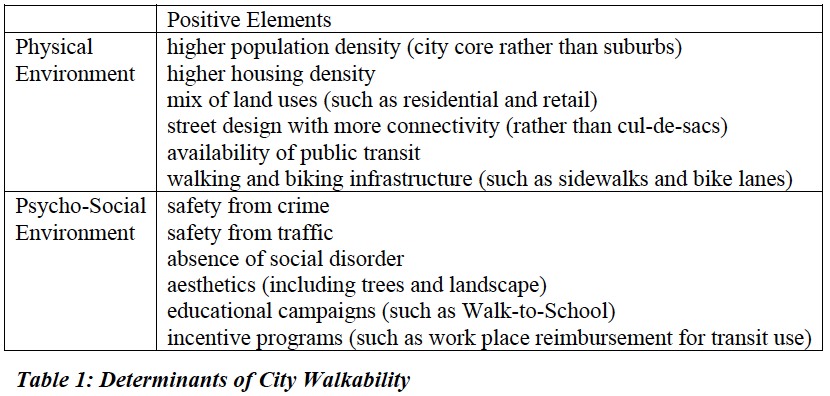
Trees and nature are an important element of outdoor environments that support activity.5,6 The following summarizes the epidemiological studies that relate urban greenspace to activity and physiological health.
Settings for Activity
There is growing interest in strategies to promote physical activity. The CDC has launched multiple programs to create urban places that can benefit groups of people rather than focusing on changing physical activity behavior one person at a time.7
The rapidly growing research base includes studies about city trees and nature. Some studies consider how the presence of parks and nature enable walking; specifically, are there adequate physical spaces within a community where activity can occur? Are there sidewalk or trail systems throughout the community? Other studies explore a more subtle question: when activity spaces are available, what is the role of trees and nature in encouraging people to be active?
Neighborhoods
A study in the Netherlands found that residents of neighborhoods with abundant greenspace generally enjoy better health than urban dwellers without access to natural areas. This positive link was found to be most apparent among the elderly, housewives, and people from lower socioeconomic groups.8
The character of neighborhoods has significant affects on residents' physical activity; thus neighborhood design is becoming a public health issue.9 Once sidewalks and trails are in place, the presence of nature influences perception of and motivation for physical activity. In a study of European urban adults, residents of areas with the highest levels of greenery were three times as likely to be physically active and 40% less likely to be overweight or obese, than those living in the least green settings.10
Also, people make more walking trips to task destinations (such as stores or coffee shops) when they perceive that there are many natural features along the route, including street-side trees. In less green neighborhoods, people judge distances to be greater than they actually are,11 perhaps leading to inclinations not to walk.
Parks & Public Open Space
Table 2 is a list of the elements associated with park use.12,13,14 Not surprisingly, the evidence to date suggests that parks and open space encourage physical activity, particularly if there is easy access to them. One study found that people who use public open spaces are three times more likely to achieve recommended levels of physical activity than those who do not use the spaces.12 Users and potential users prefer nearby, attractive, and larger parks and open spaces.

To date, few studies have tested for user response associated with vegetation character and management in parks, so the specific role of the urban forest is uncertain.
Trails
Trails can be found anywhere, from national and state parks to urban areas. By 2005, the Rails-to-Trails Conservancy tallied 12,000 miles of trails in the U.S. Future studies can help identify the features most likely to encourage active use by cyclists and pedestrians.
One study tested people's stress response, measured as elevated blood pressure, to long walks in various environments.15 Those who walked in a nature preserve showed a decline in blood pressure, while blood pressure increased for those walking in the urban environment. In addition, subjects walking in the nature reserve reported an increase in positive emotions, while those in the urban environment reported fewer such feelings.
Environmental Stewardship
Largely overlooked in research to date is the role of volunteering in environmental stewardship programs and health. Volunteer stewards of all ages who routinely tend trees or work on urban forestry projects are likely to gain health benefits from physical exertion.
One way to measure physical exertion is the metabolic ratio of an activity versus rest conditions. Walking is a recommended moderate activity (3.5 exertion ratio). Stewardship activities produce exertion ratios of 2.5 for mowing a lawn, 4.5 for planting trees or shrubs (pruning or weeding), 5.0 for digging in soil, and 6.0 for gardening with heavy tools or using a chain saw.16 Citizens can derive health benefits when they help steward nearby parks, trails, and street trees in addition to their use of these amenities.
Activity & Life Cycle
Another research perspective is the effect of natural environments on activity levels for people in various age groups. The urban elderly, young people, and people with a secondary education, specifically, seem to derive more benefit from the presence of green areas in their living environment than other groups.8
Children & Young People
The effects of insufficient physical activity are not limited to adults. About two-thirds of U.S. young people in grades 9 through 12 are not engaged in recommended levels of physical activity. The number of overweight children aged 6 to 11 more than tripled in the past 30 years, going from 6.5% or the population in 1980 to 19.6% in 2008. This condition more than tripled among adolescents aged 12 to 19, increasing from 5 to 18.1 percent over the same period.17
Walk-to-School programs encourage children to be more active, though perceived safety is an important determining factor in participation. Studies of school walkability found that adjacent land use, walking time of day, and presence of sidewalks and trees were factors that parents considered before allowing their children to walk to school. Streets having sidewalks at least 5 feet wide and an 8-foot-wide tree lawn with trees as a roadside buffer tested highest for perceived safety by parents.18
The availability of neighborhood facilities for physical activity may be particularly relevant for adolescents, who are unable to drive and whose activity is often limited to the distance they are able to walk or bicycle. Physical activity levels often decline substantially among pubescent girls , depending, in part, on the availability of nearby natural environments. A study found that these girls participated in more non-school moderate activity if nearby parks with shaded areas were available. Girls’ activity rates more than doubled in areas that were conducive to walking: miniparks, natural resource areas, walking paths, and tracks.19
The Elderly
A remarkable 5-year study of senior citizens in Japan found that having readily available space for taking walks and the presence of parks and tree-lined streets near the residence were significant predictors of higher survival rates. Living in areas with walkable greenspaces positively influenced the longevity of urban senior citizens independent of their age, sex, marital status, baseline functional status, and socioeconomic status.20
Another study of older adults revealed that longer visits to a park were associated with lower blood pressure than shorter visits.21
The duration and level of physical activity is also important: 30 to 60 minutes of fast walking several times a week has been shown to improve cognitive function in older people, particularly women.22
It’s All in the Mind
Studies show that the motivations to pursue physical activity are complex, and that natural enviroments play an important role. People in cities often feel stressed. If a person feels a need for a restorative experience then he or she is more likely to prefer a natural environment rather than a built environment for taking a walk.23
People in large cities perceive themselves to be generally more healthy if a greater percentage of the living environment is greenspace,8 are inclined to be more active, and claim the ability to relax faster.24
Why does the presence of nature motivate people to be more active? The “biophilia hypothesis” asserts that humans have an innate attraction to the outdoor environment due to our evolutionary history.25 Many studies indicate the widespread aesthetic preferences that people have for trees, water and other elements of nature. More directly, green areas in one’s living environment may ameliorate air pollution and urban heat island effects, creating more comfortable activity settings.26
City trees and green space are important to public health. They are more than just a luxury and should be given more attention in urban planning and development. Green elements should be more directly included in the approaches of programs such as Active Community Environments (ACES), a major initiative of the Centers for Disease Control and the Robert Wood Johnson Foundation’s innovative Active Living by Design. Science tells us that trees and green spaces are an important public health investment.
Project support was provided by the national Urban and Community Forestry program of the USDA Forest Service, State and Private Forestry. Summary prepared by Kathleen Wolf, Ph.D., June 14, 2010.
References
1. Wolf, K.L. 2008. City Trees, Nature and Physical Activity: A Research Review. Arborist News 17, 1:22-24.
2. Centers for Disease Control and Prevention. 2012. Overweight and Obesity. www.cdc.gov/obesity/data/adult.html
3. Brennan Ramirez, L.K., C.M. Hoehner, R.C. Brownson, R. Cook, C.T. Orleans, M. Hollander, D. C. Barker, P. Bors, R. Ewing, R. Killingsworth, K. Petersmarck, T. Schmid, and W. Wilkinson. 2006. Indicators of Activity-Friendly Communities: An Evidence-Based Consensus Process. American Journal of Preventive Medicine 31, 6:515-524.
4. Transportation Research Board (TRB). 2005. Does the Built Environment Influence Physical Activity?: Examining the Evidence. TRB Special Report 282. National Research Council, Washington, DC. 269 pp.
5. Frumkin, H. 2003. Healthy Places: Exploring the Evidence. American Journal of Public Health 93, 9:1451-1456.
6. Pretty, J., J. Peacock, M. Sellens, and M. Griffin. 2005. The Mental and Physical Health Outcomes of Green Exercise. International Journal of Environmental Health Research 15, 5:319-337.
7. Centers for Disease Control. 2010. Physical Activity Resources for Health Professionals. Accessed on May 3, 2010: www.cdc.gov/nccdphp/dnpa/physical/health_professionals/active_environments/index.htm
8. Maas, J., R.A. Verheij, P.P. Groenewegen, S. de Vries, and P. Spreeuwenberg. 2006. Green Space, Urbanity, and Health: How Strong is the Relation? Journal of Epidemiology and Community Health 60:587–592.
9. Suminski, R.R., W.S. Carlos Poston, R.L. Petosa, E. Stevens, and L.M. Katzenmoyer. 2005. Features of the Neighborhood Environment and Walking by U.S. Adults. American Journal of Preventive Medicine 28, 2:149-155.
10. Ellaway, A., S. Macintyre, and X. Bonnefoy. 2005. Graffiti, Greenery, and Obesity in Adults: Secondary Analysis of European Cross Sectional Survey. British Medical Journal 331:611-612.
11. Tilt, J.H., T.M. Unfried, and B. Roca. 2007. Using Objective and Subjective Measures of Neighborhood Greenness and Accessible Destinations for Understanding Walking Trips and BMI in Seattle, Washington. American Journal of Health Promotion 21, 4:371-379.
12. Giles-Corti, B., M.H. Broomhall, M. Knuiman, C. Collins, K. Douglas, K. Ng, A. Lange, and R.J. Donovan. 2005. Increasing Walking: How Important is Distance to, Attractiveness, and Size of Public Open Space? American Journal of Preventive Medicine 28:169-176.
13. Wells, N.M., S.P. Ashdown, E.H.S. Davies, F.D. Cowett, and Y. Yang. 2007. Environment, Design, and Obesity: Opportunities for Interdisciplinary Collaborative Research. Environment and Behavior 39, 1:6-33.
14. Harrison, C., J. Burgess, A. Millward, and G. Dawe. 1995. Accessible Natural Greenspace in Towns and Cities: A Review of Appropriate Size and Distance Criteria. English Nature Research Report No.153. Peterborough, UK.
15. Hartig, T., G.W. Evans, L.D. Jamner, D.S. Davis, and T. Gärling. 2003. Tracking Restoration in Natural and Urban Field Settings. Journal of Environmental Psychology 23:109-123.
16. Ainsworth, B.E., W.L. Haskell, A.S. Leon, D.R. Jacobs Jr., H.J. Montoye, J.F. Sallis, and R.S. Paffenbarger Jr. 1993. Compendium of Physical Activities: Classification of Energy Costs of Human Physical Activities. Medicine and Science in Sports and Exercise 25:71-80.
17. Centers for Disease Control. 2010. Healthy Youth! Accessed on May 3, 2010: www.cdc.gov/HealthyYouth/overweight/index.htm
18. Naderi, J.R., and J.-H. Kim. 2006. Reconceiving Typical Standards for Public Space: Implementing Enhanced Walking Environments for Children. In: P. Mooney (ed.), Shifting Ground: Landscape Architecture in the Age of the New Normal. Proceedings of the CSLA/CELA 2006 Congress. University of British Columbia, Vancouver, Canada.
19. Cohen, D.A., J.S. Ashwood, M.M. Scott, A. Overton, K.R. Evenson, L.K. Staten, D. Porter, T.L. McKenzie, and D. Catellier. 2006. Public Parks and Physical Activity Among Adolescent Girls. Pediatrics 118, 5:e1381-1389.
20. Takano, T., K. Nakamura, and M. Watanabe. 2002. Urban Residential Environments and Senior Citizens’ Longevity in Mega-City Areas: The Importance of Walkable Green Space. Journal of Epidemiology and Community Health 56, 12:913–916.
21. Mowen, A. 2003. Community Efforts, Community Health. Parks and Recreation 38, 5:36-39.
22. Colcombe, S., and A.F. Kramer. 2003. Fitness Effects on the Cognitive Function of Older Adults: A Meta-Analytic Study. Psychological Science 14, 2:125–130.
23. Staats, H., A. Kieviet, and T. Hartig. 2003. Where to Recover From Attentional Fatigue: An Expectancy-Value Analysis of Environmental Preference. Journal of Environmental Psychology 23:147-157.
24. Payne, L., B. Orsega-Smith, G. Godbey, and M. Roy. 2005. Local Parks and the Health of Older Adults: Results From an Exploratory Study. Journal of Parks and Recreation 33, 10:64–71.
25. Kellert, S.R., and E.O. Wilson (eds.). 1993. The Biophilia Hypothesis. Island Press, Washington, DC. 484 pp.
26. Tzoulas, K., K. Korpela, S. Venn, V. Yli-Pelkonen, A. Kazmierczak, J. Niemela, and P. James. 2007. Promoting Ecosystem and Human Health in Urban Areas Using Green Infrastructure: A Literature Review. Landscape and Urban Planning 81:167–178.
27. Finkelstein, E.A., J.G. Trogdon, J.W. Cohen, and W. Dietz. 2009. Annual Medical Spending Attributable to Obesity: Payer-and Service-specific Estimates. Health Affairs 28, 5: w822-831.
28. Centers for Disease Control and Prevention. 2010. U.S. Physical Activity Statistics. www.cdc.gov/nccdphp/dnpa/physical/stats/index.htm
 positive landscape aesthetics supports active living
positive landscape aesthetics supports active living
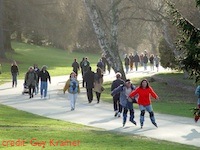 having parks and green space near one's home encourages participation in physical activity
having parks and green space near one's home encourages participation in physical activity
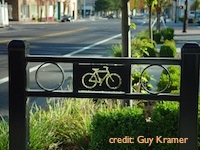 a green streetscape supports "Complete Streets" for walking and bicycling
a green streetscape supports "Complete Streets" for walking and bicycling
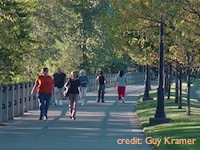 a tree lawn creates a pleasant, and separated walkable space
a tree lawn creates a pleasant, and separated walkable space
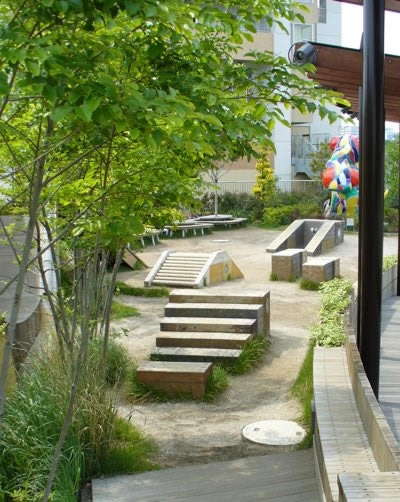 active living is important for children, and nature experience is an important element
active living is important for children, and nature experience is an important element